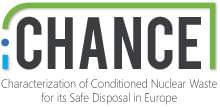WP3 – Calorimetry associated with non-destructive assay techniques and uncertainties study
Objectives
WP3 consists in the testing and evaluation of the performance of calorimetry as an innovative non-destructive technique, complementary to current techniques, to reduce uncertainties on the inventory of radionuclides. Calorimetry is one of the solutions to estimate the overall quantity of nuclear material on a wide range of mass, from a few milligrams up to kilograms of radionuclides, by measuring the overall thermal power coming from the radionuclides due to the radioactive decay. Up to now calorimetry has been used mainly to quantify raw material (Pu and isotopes or 3H) for inventory purposes.
During the first year a general study will be undertaken to address specific issues concerning the characterization of conditioned radioactive waste by means of different techniques combined with calorimetry. Some real problematic waste characterization cases will be selected. Benchmarks of the existing calorimeters installed in different facilities in France (CEA), UK (AWE), USA (LANL, LLNL, SRS) will be done. Different modes of operation will be taken into account: heat flux calorimeter, compensation calorimeter, adiabatic calorimeter. A benchmark of NDA techniques used with calorimetry (Gamma spectrometry, X-Ray imaging, passive neutron counting, active neutron interrogation) will also be carried out. Some estimation of uncertainties for the selected cases complemented by numerical studies will be done in order to demonstrate in which cases calorimetry combined with other techniques is useful and will lower the quantification uncertainties of the various radionuclides contained in the wastes. This work will be done by KEP Nuclear, CEA, SCK•CEN, WUT and FZJ.
A first technical feasibility of a new calorimeter for very large volume waste will be done based on the conclusion of the benchmarking. A new 200 liters calorimeter, with lowered detection limit, will be developed by KEP Nuclear, manufactured and tested. An experimental program taking into account the development or choice of the different analytical techniques and sample preparation will be established and some measurements will be undertaken with some mock-up drums in CEA Cadarache and possibly real drums in SCK•CEN Mol. The experimental program will produce a large volume of unique data to be processed. These experimental investigations will be presented in a report. The results obtained by means of each technique (= 1st level analysis) will be done. Techniques will be the NDA techniques and calorimetric measurement. In the 1st level analysis, techniques are not combined and the performance of each technique is analyzed. A comparison of the different uncertainty sources for each characterization technique will be done by FZJ WUT in collaboration with CEA and SCK•CEN. A second analysis will be carried out by combining the results from the different techniques (= 2nd level analysis) in order to describe and optimize the combination of different techniques in realistic configurations compared to individual characterization techniques. This work will be done by FZJ and WUT with CEA and SCK•CEN. A final report will present the conclusion of the exhaustive study of uncertainties related to NDA characterization methods in conjunction with calorimetry in order to reduce the uncertainties on specific waste characterization cases.
Deliverables
D3.1 Applicability of calorimetry to real waste characterization
D3.2 Calorimeter prototype
D3.3 Results of experimental investigation of calorimetry applicability
D3.4 Conclusion of the exhaustive study of uncertainties related to NDA characterization methods in conjunction with calorimetry
Partners involved
Leader: KEP Nuclear
Contributors: CEA, SCK•CEN, FZJ, WUT
